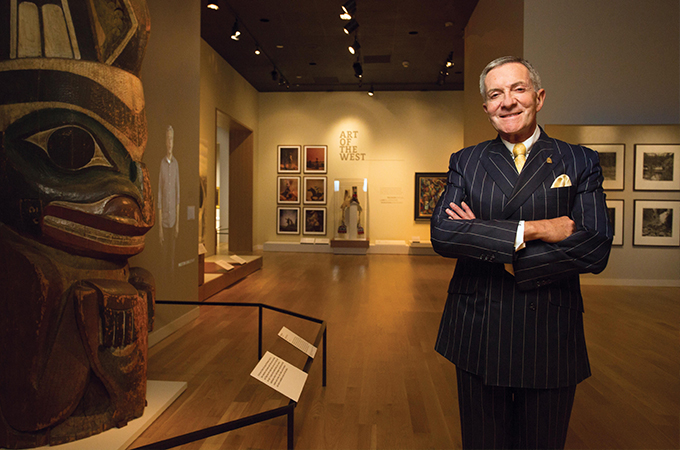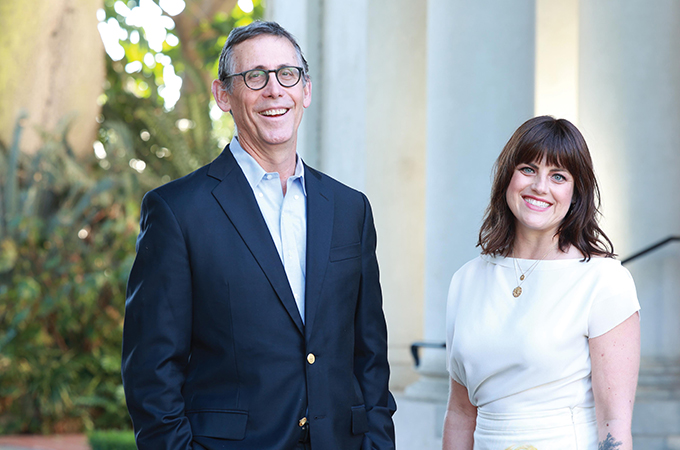Three Bulldogs in the museum world— Vanessa Wilkie ’00, Daniel Lewis ’81, and Rick West ’65—talk about how their Redlands education helps them ask questions and tell stories.
Vanessa Wilkie ’00: ‘I learned not to be afraid of asking questions’
Vanessa Wilkie ’00 says University of Redlands Professor Jim Sandos’s class sparked her passion for history, but it was a semester abroad in Salzburg that led her to abandon plans for law school and move forward, by investigating the past.
In Europe, not only did she get to see and touch actual sites where significant historical events occurred, she also had a front-row seat to history in the making. Wilkie recalls, “I remember sitting at a McDonald’s [in Budapest], talking to our Hungarian host about living in a country that had been behind the Iron Curtain and what it could mean for Hungary to join NATO. You don’t get that experience easily, but Redlands made it possible.”
Curating as connection
Wilkie, who double-majored in government and history at Redlands, says her experience directly impacts her current work as the curator of the Huntington Library’s collections of medieval manuscripts and British history.
“A liberal arts education is about figuring out logical ways to blend the subjects that seem disparate but are actually connected to the way we think about the world,” she says. “So much of
U of R’s teaching is about professors asking students questions instead of the other way around. I learned not to be afraid of asking questions.”
After Redlands, Wilkie went on to earn her Ph.D. in British history from University of California, Riverside. She was the Lossett Visiting Professor of History at the University of Redlands before joining the Huntington in 2013.
Wilkie is also on the Huntington’s advisory committee for the arts initiative named /five. Her team collaborates with arts and cultural organizations to encourage the use of the Huntington’s library, garden, and art collections in innovative ways, whether with site-specific installations, educational programming, performance pieces, film, or other art forms.
Developing a curatorial voice
The initiative has allowed Wilkie to develop her curatorial voice by assessing the library’s collections and highlighting voices that have been marginalized and silenced in the past. When museums closed during the pandemic, the Huntington staff used the time to rethink how they presented the library collections. “The world has changed dramatically since 2013,” she says. “We took the opportunity to refresh our exhibits in ways that are more relevant to the conversations people are having today.”
One example is the presentation of the Ellesmere Chaucer edition of Geoffrey Chaucer’s The Canterbury Tales, the most complete version of the text and one of the most important works in the library’s collection. “The exhibit used to be exclusively focused on England and the 14th and 15th centuries,” she explains. “Now, the display brings [out stories of that time putting] England in conversation with the rest of Europe, which more accurately reflects what was happening during
the Renaissance.”
Her constant reinvestigation of the perceived canon is partly due to her liberal arts education at Redlands. To this day, it helps her read historical text and ask the right questions—about the past, and moving toward the future. “I think this is a time for museums to be bolder and brighter; as I develop my curatorial voice, I want to encourage institutions to be braver about reconciling with their past and the impact they’ve had on the way the public engages with history and art.”
Daniel Lewis ’81: ‘Everything has a history’
Daniel “Dan” Lewis ’81 has worked as a curator in different capacities at the Huntington Library for 25 years, but his love for books had humble beginnings. Growing up in Hawaii, his family rented a television once every four years to watch the Olympics, but otherwise he had to entertain himself with printed material.
Now the Dibner Senior Curator for the History of Science and Technology in the library’s Curatorial Collections Department, Lewis spends his days with rare books and manuscripts—buying them at auctions, assessing their authenticity, curating informational exhibits, and helping visiting researchers find material for a vast array of projects.
While his love of books began in childhood, his interest in rare materials developed when he worked as an associate archivist at the A.K. Smiley Public Library under U of R Trustee Larry Burgess ’67, who was head of special collections at the time.
On his first day, Lewis transcribed a letter written during the Civil War. Witnessing the irreplaceability of such items for the first time, “I was hooked,” Lewis says. “I’ve never really looked back.”
Infinite opportunity
A top-ranked junior tennis player in Hawaii, Lewis was lured to the mainland by Redlands’ tennis program—then led by Coach Jim Verdieck—and the promise of a liberal arts education.
Lewis quickly formed a network of close-knit friends at Fairmont Hall, due in part to his participation as an editor of the University literary magazine, Zanja. He loved Professors Bruce McAllister and the late Ralph Angel, who were critical to launching his career: “They were so accessible and inspirational.”
Lewis says his time at the University of Redlands as an English and creative-writing student has been essential to his work as a storyteller and writer. Beyond that, being a Bulldog gave Lewis a feeling of infinite opportunity, which was a stark contrast to the harsh environment of the boarding school he had previously attended. Redlands prepared him to succeed beyond campus: “I felt like I could do anything.”
A unique perspective
Daily, Lewis and his colleagues manage one of the world’s most extensive and renowned independent research libraries. Apart from housing books, the Huntington’s library contains other materials among its 11 million items, from truly extraordinary books and manuscripts to those without a lot of research value, such as the knife used to stab Secretary of State William H. Seward the night of Abraham Lincoln’s assassination. The diversity of objects, manuscripts, and other materials that the library owns makes for an equally unique population of researchers from around the world who want to access them.
Interacting with those researchers, called “readers” by the library, is one of the most rewarding aspects of Lewis’s job: “The fact that researchers produce knowledge that radiates out to a wider world and is used in all sorts of ways is really satisfying.”
A researcher himself, Lewis is now writing his fourth book, which investigates 12 species of trees from around the world and takes a journalistic approach to a story of conservation. Writing combines Lewis’s three passions—books, history, and nature—and he takes the same approach to writing as he does to curation.
“Everything has a history,” he says, noting that some writers can draw others into topics they never knew they could be interested in. “You can see [a person’s] world tilt on its axis a degree or two when that happens.”

Rick West ’65: ‘Redlands showed me the beauty of what can happen’
By the time Rick West ’65 retired as president and CEO of the Autry Museum of the American West last summer, he’d already spent most of his career in high-profile jobs, including clerking at the U.S. Court of Appeals for the Ninth Circuit in San Francisco, representing Native American interests as a constitutional and legal spokesman in Washington, D.C., and serving as the founding director of the Smithsonian Institution’s National Museum of the American Indian.
Elevating Native culture
For all these jobs, however, he had one motivation: the desire to elevate Native American civil rights and culture. West, a citizen of the Cheyenne and Arapaho tribes of Oklahoma, took a circuitous path to this mission. At the University of Redlands, he majored in American history and political science and graduated magna cum laude. He says, “I loved Redlands because learning expanded my notion of American democracy, pluralism, and what that meant in terms of inclusivity.” Afterward, he earned his master’s at Harvard University. However, “I didn’t hear much Native history in what I was being taught about American history at Harvard. And this was in the 1960s, where there was this pulsation to change and question things, going from the retrospective to the perspective.”
He pivoted and decided to go to Stanford Law School, “for the very specific purpose of practicing American Indian law.” Partly, he credits this change of direction to the U of R. “Redlands had such a significant role in my educational grounding—it gave me the gift of a liberal arts education, so that I was able to find my own way and choose [my path] afterward. I had lots of opportunities to expand my horizon. … My experience showed me the beauty of what can happen.”
A Redlands legacy and continued engagement
Born in San Bernardino, West was raised in Muskogee, Oklahoma, by artists who were also academics; his father, Walter Richard West Sr., was a renowned painter and art professor. “If I had a nickel for every hour my brother and I spent playing in museums as a child while my father was doing business, I’d be rich,” he says. His mother, Maribelle McCrea West ’34, a piano major who earned a bachelor’s in music and a bachelor’s in English, was a music professor; it was because of her that Rick and his brother, James Lee West ’68, attended Redlands.
Rick still sits on advisory boards at various institutions and has maintained a consistent engagement at Redlands through the years, serving as a trustee from 1993 to 2002 and on the Alumni Association Board of Directors. Today, he sits on the Partnership for Native Students Steering Committee at Redlands.
Now that he’s retired, he’s eager to travel and spend more time with his grandchildren. But he’s also excited about his next chapter—literally.
“I’ve spent much of my professional life in museums and on environmental issues, but I also want more time to write,” he says. “People have talked to me about writing a memoir, but I feel my legacy comes out in different forms. Generationally, it appears in my daughter’s practice as a doctor and faculty member at the University of Southern California Keck School of Medicine. It also comes out in my son’s work; he’s a filmmaker working on a documentary on sports teams and mascots called Imagining the Indian. The long-term impact of my work as a lawyer pursuing Native rights and as a museum director is very much a part of my family’s life.”
Explore the Fall 2021 issue of Och Tamale magazine.






